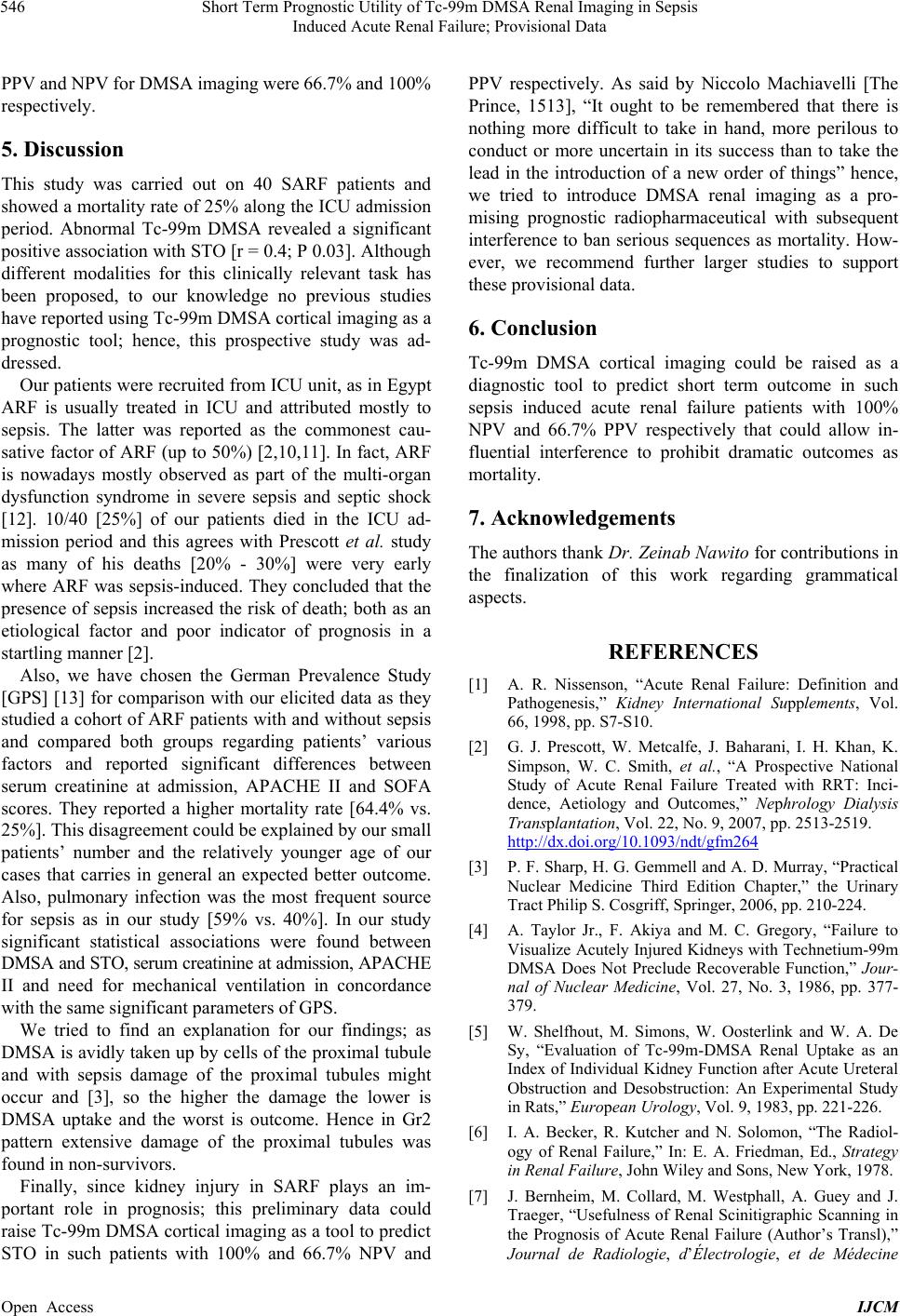
Short Term Prognostic Utility of Tc-99m DMSA Renal Imaging in Sepsis
Induced Acute Renal Failure; Provisional Data
546
PPV and NPV for DMSA imaging were 66.7% and 100%
respectively.
5. Discussion
This study was carried out on 40 SARF patients and
showed a mortality rate of 25% along the ICU admission
period. Abnormal Tc-99m DMSA revealed a significant
positive asso ciation with STO [r = 0.4; P 0.03]. Although
different modalities for this clinically relevant task has
been proposed, to our knowledge no previous studies
have reported using Tc-99m DMSA cortical imaging as a
prognostic tool; hence, this prospective study was ad-
dressed.
Our patients were recruited from ICU unit, as in Egypt
ARF is usually treated in ICU and attributed mostly to
sepsis. The latter was reported as the commonest cau-
sative factor of ARF (up to 50%) [2,10,11]. In fact, ARF
is nowadays mostly observed as part of the multi-organ
dysfunction syndrome in severe sepsis and septic shock
[12]. 10/40 [25%] of our patients died in the ICU ad-
mission period and this agrees with Prescott et al. study
as many of his deaths [20% - 30%] were very early
where ARF was sepsis-induced. They concluded that the
presence of sepsis increased the risk of death; both as an
etiological factor and poor indicator of prognosis in a
startling manner [2].
Also, we have chosen the German Prevalence Study
[GPS] [13] for comparison with our elicited data as they
studied a cohort of ARF patients with and without sepsis
and compared both groups regarding patients’ various
factors and reported significant differences between
serum creatinine at admission, APACHE II and SOFA
scores. They reported a higher mortality rate [64.4% vs.
25%]. This disagreement could be explained by our small
patients’ number and the relatively younger age of our
cases that carries in general an expected better outcome.
Also, pulmonary infection was the most frequent source
for sepsis as in our study [59% vs. 40%]. In our study
significant statistical associations were found between
DMSA and STO, serum creatinine at admission, APACHE
II and need for mechanical ventilation in concordance
with the same significant parameters of GPS.
We tried to find an explanation for our findings; as
DMSA is avidly taken up by cells of the proximal tubule
and with sepsis damage of the proximal tubules might
occur and [3], so the higher the damage the lower is
DMSA uptake and the worst is outcome. Hence in Gr2
pattern extensive damage of the proximal tubules was
found in non-survivors.
Finally, since kidney injury in SARF plays an im-
portant role in prognosis; this preliminary data could
raise Tc-99m DMSA cortical imaging as a tool to predict
STO in such patients with 100% and 66.7% NPV and
PPV respectively. As said by Niccolo Machiavelli [The
Prince, 1513], “It ought to be remembered that there is
nothing more difficult to take in hand, more perilous to
conduct or more uncertain in its success than to take the
lead in the introduction of a new order of things” hence,
we tried to introduce DMSA renal imaging as a pro-
mising prognostic radiopharmaceutical with subsequent
interference to ban serious sequences as mortality. How-
ever, we recommend further larger studies to support
these provisional data.
6. Conclusion
Tc-99m DMSA cortical imaging could be raised as a
diagnostic tool to predict short term outcome in such
sepsis induced acute renal failure patients with 100%
NPV and 66.7% PPV respectively that could allow in-
fluential interference to prohibit dramatic outcomes as
mortality.
7. Acknowledgements
The authors thank Dr. Zeinab Nawito for contributions in
the finalization of this work regarding grammatical
aspects.
REFERENCES
[1] A. R. Nissenson, “Acute Renal Failure: Definition and
Pathogenesis,” Kidney International Supplements, Vol.
66, 1998, pp. S7-S10.
[2] G. J. Prescott, W. Metcalfe, J. Baharani, I. H. Khan, K.
Simpson, W. C. Smith, et al., “A Prospective National
Study of Acute Renal Failure Treated with RRT: Inci-
dence, Aetiology and Outcomes,” Nephrology Dialysis
Transplantation, Vol. 22, No. 9, 2007, pp. 2513-2519.
http://dx.doi.org/10.1093/ndt/gfm264
[3] P. F. Sharp, H. G. Gemmell and A. D. Murray, “Practical
Nuclear Medicine Third Edition Chapter,” the Urinary
Tract Philip S. Cosgriff, Springer, 2006, pp. 210-224.
[4] A. Taylor Jr., F. Akiya and M. C. Gregory, “Failure to
Visualize Acutely Injured Kidneys with Technetium-99m
DMSA Does Not Preclude Recoverable Function,” Jour-
nal of Nuclear Medicine, Vol. 27, No. 3, 1986, pp. 377-
379.
[5] W. Shelfhout, M. Simons, W. Oosterlink and W. A. De
Sy, “Evaluation of Tc-99m-DMSA Renal Uptake as an
Index of Individual Kidney Function after Acute Ureteral
Obstruction and Desobstruction: An Experimental Study
in Rats,” European Urology, Vol. 9, 1983, pp. 221-226.
[6] I. A. Becker, R. Kutcher and N. Solomon, “The Radiol-
ogy of Renal Failure,” In: E. A. Friedman, Ed., Strategy
in Renal Failure, John Wiley and Sons, New York, 1978.
[7] J. Bernheim, M. Collard, M. Westphall, A. Guey and J.
Traeger, “Usefulness of Renal Scinitigraphic Scanning in
the Prognosis of Acute Renal Failure (Author’s Transl),”
Journal de Radiologie, d’Électrologie, et de Médecine
Open Access IJCM